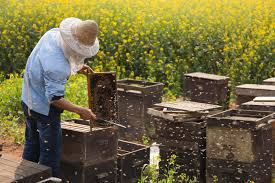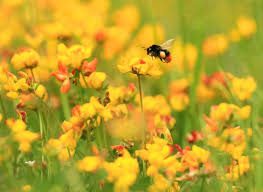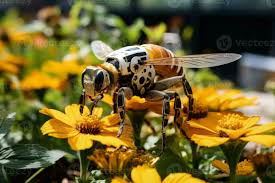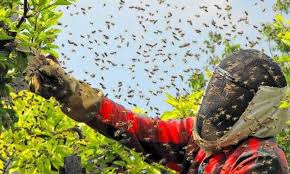Pollinators in agriculture are crucial for enhancing crop yields and ensuring food security. Approximately 75% of the world’s flowering plants and 35% of global food production depend on animal pollination, making these creatures essential for cultivating fruits, vegetables, nuts, and seeds.
Among the various pollinators, bees, butterflies, birds, bats, and other insects play prominent roles, with bees alone responsible for pollinating about 70 of the top 100 crop species.
This contribution not only boosts the quantity of food produced but also improves the quality of crops by promoting better seed and fruit development.
In agricultural systems, pollinators directly impact the yields of numerous crops, leading to increased harvests and enhanced profitability for farmers. For instance, crops such as apples, almonds, blueberries, and tomatoes thrive with the help of pollinators. Without them, many of these crops would produce significantly fewer fruits or seeds, resulting in reduced availability and higher prices for consumers.
The economic value of pollination services is staggering, estimated to be worth billions of dollars annually. Therefore, healthy pollinator populations are crucial for sustainable agricultural practices and food supply chains.
The presence of pollinators also encourages biodiversity within agricultural landscapes. Diverse ecosystems are more resilient and productive, providing a range of habitats and food sources for various organisms.
By promoting plant diversity, pollinators contribute to a balanced ecosystem that supports not only agricultural activities but also wildlife and natural processes. This interconnectedness highlights the significance of maintaining pollinator populations to ensure the overall health of agricultural systems.
Beyond agriculture, pollinators are essential for the stability of ecosystems. They facilitate the reproduction of flowering plants, which form the basis of many ecosystems by providing food and habitat for various species, including birds, insects, and mammals.
Healthy plant communities, in turn, support soil health, water retention, and climate regulation. As pollinators transfer pollen from one flower to another, they enable the genetic exchange necessary for plants to adapt to changing environments, which is critical in the face of climate change.
Moreover, pollinators help maintain the balance of ecosystems by supporting the growth of wild plants that provide shelter and food for various animals. Many wild fruits, nuts, and seeds also depend on pollination, contributing to the diets of many wildlife species and supporting their populations.
This relationship underscores the intricate web of life in which pollinators, plants, and animals coexist, highlighting their role as key players in maintaining ecological balance.
However, despite their significance, pollinator populations are declining due to factors such as habitat loss, pesticide use, climate change, and diseases.
The reduction of pollinators poses a threat to both agricultural productivity and ecosystem health, emphasizing the urgent need for conservation efforts. Protecting and restoring habitats, promoting sustainable agricultural practices, and reducing chemical inputs are vital strategies to ensure that pollinators continue to thrive.
Types of Pollinators
1. Bees: The most effective and common pollinators, bees are responsible for pollinating approximately 70 of the 100 crop species that feed 90% of the world. They include honeybees, bumblebees, and solitary bees. Their hairy bodies collect pollen, which they transfer as they move from flower to flower.
2. Butterflies and Moths: These insects are attracted to flowers for their nectar. While they are not as efficient as bees, they contribute to pollination, particularly for plants with tubular flowers.
3. Birds: Hummingbirds are the primary avian pollinators, known for their ability to hover and access nectar in flowers. They play a key role in the pollination of many tropical and subtropical plants.
4. Bats: In some regions, bats are essential pollinators, particularly for night-blooming plants. They are known to pollinate fruit species like bananas, avocados, and agave.
5. Other Insects: Various insects such as beetles, flies, and wasps also contribute to pollination, though their effectiveness varies. Each has its preferred plants and methods of pollination.
Pollinators and Agricultural Productivity

Pollinators significantly enhance agricultural productivity by increasing the quantity and quality of crops. Studies show that about 75% of global food crops depend on animal pollination, highlighting the importance of pollinators in food production systems.
The presence of pollinators leads to higher yields and the production of better-quality fruits, vegetables, and nuts, which can result in increased economic returns for farmers.
Impact of Pollinators on Crop Quality
Pollinators not only boost crop quantity but also improve crop quality. Pollination leads to better seed set, which can enhance fruit size, flavor, and nutritional value. For example, crops like tomatoes, berries, and almonds produce better yields when pollinated by bees, resulting in tastier and more appealing products.
Additionally, well-pollinated plants often have a longer shelf life and better resistance to diseases, which is beneficial for both consumers and producers.
Read Also: Trichomoniasis: Description, Damages Caused, Control and Preventive Measures
Biodiversity and Ecosystem Health

Pollinators are integral to maintaining biodiversity and ecosystem health. They help sustain a diverse range of plant species, which in turn supports other wildlife and contributes to the overall health of ecosystems.
A diverse plant community can enhance soil health, regulate water cycles, and provide habitats for various organisms. The decline of pollinator populations can disrupt these ecological processes, leading to reduced biodiversity and impaired ecosystem functions. Protecting and promoting pollinator habitats is essential for preserving these vital services.
Threats to Pollinator Populations
Pollinators face numerous threats that have led to significant declines in their populations worldwide. Understanding these threats is crucial for implementing effective conservation strategies.
1. Habitat Loss: Urbanization, agricultural expansion, and land-use changes have led to the destruction and fragmentation of natural habitats. As wildflower populations dwindle, pollinators lose essential food sources and nesting sites, making it challenging for them to survive.
2. Pesticide Use: The widespread application of pesticides, particularly neonicotinoids, poses a significant risk to pollinator health. These chemicals can be toxic to bees and other pollinators, leading to disorientation, reduced reproduction, and even death. Exposure to pesticide residues can weaken pollinators, making them more vulnerable to diseases.
3. Climate Change: Changing climate patterns impact the availability of flowering plants and disrupt the timing of plant-pollinator interactions. As temperatures rise and weather patterns shift, pollinators may struggle to find food sources or suitable habitats, affecting their populations.
4. Disease and Parasites: Pollinators, especially honeybees, are susceptible to various diseases and parasites, such as Varroa mites, Nosema fungi, and viruses. These threats can weaken bee colonies, leading to reduced pollination capacity and potential colony collapse.
5. Monoculture Farming: Agricultural practices that rely heavily on monocultures can reduce biodiversity and limit food sources for pollinators. The lack of diverse flowering plants in agricultural landscapes diminishes habitat availability and foraging opportunities for pollinators.
Read Also: List of Diseases Ruminant Animals (Livestock) Get from Feeds and Water
Benefits of Pollinators Beyond Agriculture

While pollinators are essential for agricultural productivity, their benefits extend far beyond crop production, contributing significantly to ecosystem health and biodiversity.
1. Ecosystem Services: Pollinators play a vital role in maintaining the balance of ecosystems. By facilitating plant reproduction, they support diverse plant communities, which are crucial for soil health, water regulation, and carbon sequestration.
2. Biodiversity Conservation: Pollinators are key to the survival of many wild plant species, promoting genetic diversity. Healthy populations of flowering plants provide habitats and food for other wildlife, contributing to overall biodiversity in ecosystems.
3. Aesthetic and Recreational Value: Pollinator-friendly landscapes enhance the aesthetic value of natural areas, parks, and gardens. The beauty of flowering plants attracts people, encouraging outdoor activities such as hiking, birdwatching, and gardening, which can benefit mental well-being and community cohesion.
4. Cultural Significance: Many cultures around the world have deep connections to pollinators and the plants they help to flourish. Festivals, traditions, and folklore often celebrate the beauty and importance of flowers, bees, and other pollinators, highlighting their role in cultural heritage.
Strategies for Protecting Pollinators
To safeguard pollinator populations and ensure their continued contribution to ecosystems and agriculture, various strategies can be implemented at individual, community, and policy levels.
1. Creating Pollinator Habitats: Individuals and communities can plant native flowers, create wildflower meadows, and establish pollinator gardens to provide food sources and nesting sites for pollinators. Using organic gardening practices helps minimize pesticide exposure.
2. Promoting Sustainable Agricultural Practices: Farmers can adopt integrated pest management (IPM) practices, crop rotation, and cover cropping to reduce pesticide use and enhance biodiversity on farms. Planting hedgerows and wildflower strips around fields can provide refuge and foraging areas for pollinators.
3. Educating and Engaging Communities: Raising awareness about the importance of pollinators and the threats they face can empower communities to take action. Educational programs and workshops can inform people about creating pollinator-friendly environments and advocating for policy changes.
4. Supporting Conservation Initiatives: Individuals can support organizations and initiatives focused on pollinator conservation through donations, volunteering, or participating in local restoration projects. Collaboration among various stakeholders, including farmers, conservationists, and policymakers, is essential for effective protection.
5. Advocating for Policy Changes: Advocating for policies that promote pollinator protection, such as stricter pesticide regulations and habitat conservation initiatives, can lead to systemic change. Engaging with local governments and participating in public discussions can amplify efforts to create a supportive environment for pollinators.
Protecting pollinators is crucial for sustaining ecosystems, enhancing biodiversity, and securing food production.
Do you have any questions, suggestions, or contributions? If so, please feel free to use the comment box below to share your thoughts. We also encourage you to kindly share this information with others who might benefit from it. Since we can’t reach everyone at once, we truly appreciate your help in spreading the word. Thank you so much for your support and for sharing!
Read Also: The Impact Of Hazardous Waste Disposal in Los Angeles
Frequently Asked Questions
We will update this section soon.

